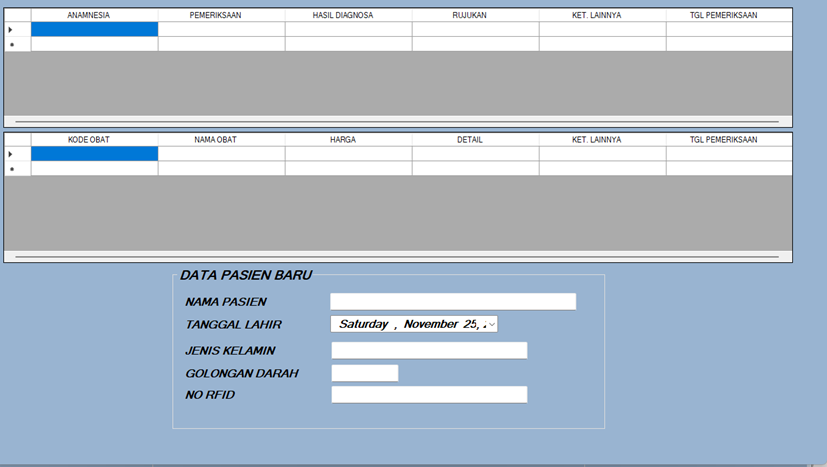Design of EMR (Electronic Medical Record) Applications Using RFID Cards to Record Patient Medical Record Data at The Sukajadi Bandung Health Center
DOI:
https://doi.org/10.59535/faase.v1i2.187Keywords:
Application, Medical, Record, RFIDAbstract
One of the supports for health services is required to be better, one of which is by making EMR (electronic medical record) applications using RFID cards as a substitute for patient medical record cards. In this case this RFID card can function as patient history data, when the patient taps the RFID card, then all the history data appears entirely. Problem Identification at this stage the author identifies the problems that occur and looks for solutions needed at the Sukajadi Community Health Center in Bandung which requires a medical record application system to assist in processing patient data, medical record data and drug data at the Sukajadi Community Health Center. This research resulted in the design of a Medical Record application at the Sukajadi Health Center, Bandung City using an RFID card. b. With the record application can help activities in managing data both patients and drug data and more efficient and safer so that doctors can add or view the patient's medical record history.
Downloads
References
Y. Zhan and Z. Xuan, ‘Medical Record Encryption Storage System Based on Internet of Things’, Wireless Communications and Mobile Computing, vol. 2021, pp. 1–9, Nov. 2021, doi: 10.1155/2021/2109267.
C.-L. Chen, P.-T. Huang, Y.-Y. Deng, H.-C. Chen, and Y.-C. Wang, ‘A secure electronic medical record authorization system for smart device application in cloud computing environments’, Hum. Cent. Comput. Inf. Sci., vol. 10, no. 1, p. 21, May 2020, doi: 10.1186/s13673-020-00221-1.
W. A. Zgallai, A. Mahdi, A. Hamad, K. Saleh, M. Abdulla, and N. Ahmed, ‘Electronic medical records integration in the UAE utilizing RFID and IOT’, in 2022 Advances in Science and Engineering Technology International Conferences (ASET), Feb. 2022, pp. 1–4. doi: 10.1109/ASET53988.2022.9735115.
D. P. Kristiadi, M. Hasanudin, Sutrisno, Jawahir, F. Sudarto, and R. Tarmizi, ‘INDHCI: Indonesian Districts Health Care Information Model’, J. Phys.: Conf. Ser., vol. 1764, no. 1, p. 012214, Feb. 2021, doi: 10.1088/1742-6596/1764/1/012214.
I. Keshta and A. Odeh, ‘Security and privacy of electronic health records: Concerns and challenges’, Egyptian Informatics Journal, vol. 22, no. 2, pp. 177–183, Jul. 2021, doi: 10.1016/j.eij.2020.07.003.
S. Tayyaba, W. Khalid, M. W. Ashraf, and V. E. Balas, ‘Chapter 11 - Principles and paradigms in IoT-based healthcare using RFID’, in Healthcare Paradigms in the Internet of Things Ecosystem, V. E. Balas and S. Pal, Eds., Academic Press, 2021, pp. 251–269. doi: 10.1016/B978-0-12-819664-9.00011-9.
R. Ganiga, R. M. Pai, M. M. Manohara Pai, R. K. Sinha, and S. Mowla, ‘Integrating NFC and IoT to Provide Healthcare Services in Cloud-Based EHR System’, in Advances in Electrical and Computer Technologies, T. Sengodan, M. Murugappan, and S. Misra, Eds., in Lecture Notes in Electrical Engineering. Singapore: Springer, 2020, pp. 361–371. doi: 10.1007/978-981-15-5558-9_33.
A. Abu-Rumman, A. Al Shraah, F. Al-Madi, and T. Alfalah, ‘The impact of quality framework application on patients’ satisfaction’, International Journal of Human Rights in Healthcare, vol. 15, no. 2, pp. 151–165, Jan. 2021, doi: 10.1108/IJHRH-01-2021-0006.
J. H. Kim et al., ‘Relationship between natural killer cell activity and glucose control in patients with type 2 diabetes and prediabetes’, Journal of Diabetes Investigation, vol. 10, no. 5, pp. 1223–1228, 2019, doi: 10.1111/jdi.13002.
O. Enaizan, B. Eneizan, M. Almaaitah, A. T. Al-Radaideh, and A. M. Saleh, ‘Effects of privacy and security on the acceptance and usage of EMR: The mediating role of trust on the basis of multiple perspectives’, Informatics in Medicine Unlocked, vol. 21, p. 100450, Jan. 2020, doi: 10.1016/j.imu.2020.100450.
S. Fairooz, S. Y. Miti, Z. Islam, and M. T. Zaman, ‘A medical history card utilizing the Blockchain technology’, in 2023 5th International Congress on Human-Computer Interaction, Optimization and Robotic Applications (HORA), Jun. 2023, pp. 1–6. doi: 10.1109/HORA58378.2023.10156689.
R. A. Abutaleb, S. S. Alqahtany, and T. A. Syed, ‘Integrity and Privacy-Aware, Patient-Centric Health Record Access Control Framework Using a Blockchain’, Applied Sciences, vol. 13, no. 2, Art. no. 2, Jan. 2023, doi: 10.3390/app13021028.
K. Zhang, W. Yang, H. Dai, and Z. Deng, ‘Cardiovascular risk following metformin treatment in patients with type 2 diabetes mellitus: Results from meta-analysis’, Diabetes Research and Clinical Practice, vol. 160, p. 108001, Feb. 2020, doi: 10.1016/j.diabres.2020.108001.
A. Gharat and G. Phadke, ‘Smart Medical Health Card for Hospital Management’, in 2022 2nd Asian Conference on Innovation in Technology (ASIANCON), Aug. 2022, pp. 1–4. doi: 10.1109/ASIANCON55314.2022.9909434.
S. Mittal, C. Monga, K. Upreti, N. Kumar, R. D. Raut, and M. S. Alam, ‘Light Weight Cryptography for Cloud-Based E-Health Records’, in 2022 7th International Conference on Communication and Electronics Systems (ICCES), Jun. 2022, pp. 690–696. doi: 10.1109/ICCES54183.2022.9835827.

Downloads
Published
How to Cite
Issue
Section
License
Copyright (c) 2023 Agung Rachmat, Ifani Hariyanti

This work is licensed under a Creative Commons Attribution 4.0 International License.
By submitting a manuscript to Frontier Advances in Applied Science and Engineering (FAASE), the author(s) agree to the following terms:
-
Copyright: The author(s) retain copyright to their work, granting Frontier Advances in Applied Science and Engineering (FAASE) the right to publish it. Articles are licensed under a Creative Commons Attribution 4.0 International License (CC BY).
-
License Grant: The CC BY license allows others to share and adapt the work for any purpose, even commercially, provided proper attribution is given to the original author(s) and the source, a link to the Creative Commons license is provided, and any changes made are indicated.
-
Author's Rights: Authors are allowed to enter into separate, additional contractual arrangements for the non-exclusive distribution of the journal's published version of the work, with proper acknowledgment of its initial publication in Frontier Advances in Applied Science and Engineering (FAASE).
-
Permissions: Reproduction, posting, transmission, or other distribution or use of the final published article, in whole or in part, requires prior written permission from Frontier Advances in Applied Science and Engineering (FAASE) and the respective author(s).
-
Attribution: Proper attribution must be given to the original author(s) and the source, indicating that the work was originally published in Frontier Advances in Applied Science and Engineering (FAASE) with a link to the published article.
-
No Warranty: The journal and its editorial team make no representations or warranties regarding the accuracy, completeness, or fitness for a particular purpose of the published work.
-
Dispute Resolution: Any disputes arising from the use of the licensed material shall be governed by the laws of [Jurisdiction] without regard to conflicts of law principles.
By submitting a manuscript to FAASE, the author(s) agree to abide by these license terms and grant the necessary rights to Frontier Advances in Applied Science and Engineering (FAASE) for the publication and dissemination of the submitted work.










